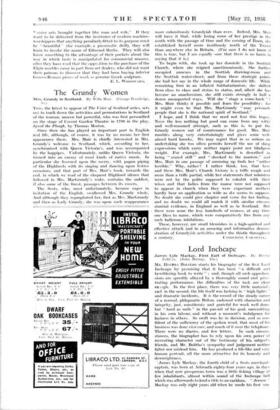De Gustibus
The Rule of Taste -from .Georg04.-to--George' IV: By John Steegmann. (Macmillan. 10s. 6d.)
Sia CHRISTOPHER WREN once wrote that the critics of his time who treated of architecture seemed to do little more than " set down the proportions of columns, architraves, and cornices in the several Orders." These proportions were " reduced into rules too strict and pedantick, and so as not to be transgressed, without the Crime of Barbarity, though in their own Nature they are but the Modes and Fashions of those ages wherein they were used. . . . Curiosity may lead us to consider whence this Affection arose originally." It is fortunate that this Curiosity has led Mr. Steegmann to make a pleasant study of the Affection of Rules and the control of taste in buildings, gardens, pictures and decoration. Mr. Steegmann's book is a causerie rather than a treatise. It is a little discursive and unmethodical. At times the style is heavy and involved ; there is, for example, on page 72, a sentence of fifteen and a half lines, with internal bumps and jolts such as " after the, so to speak, publication of selected aspects . - ." Many of the historical generalisations are too sweeping. It is definitely wrong to say that the Reform Act of 1832 " benefited exclusively . . . the middle class " ; it is more than misleading to describe the French Revolution of 1789 as a result of the Romantic movement. The bibliography, even for non- professional readers, might have been longer. Mr.M. S. Briggs' The Architect in History and Mr. G. F. Hudson's Europe and China should have been mentioned. Mr. Steegmann discusses Chippendale, but does not say a word about Hepplewhite. He explains the status of architects in the eighteenth century ; he leaves out of account the rise of the civil engineer.
One may mention these defects, not merely because a reviewer must say what he thinks about a book, but also because this particular book can carry a good many faults. It is a most interesting book. Mr. Steegmann might well expand it into a more elaborate study, and add to it a volume on the " revivals " of the nineteenth century, and the quick changes and experiments of the last thirty or forty years. Few people today know the history of the curious Queen Anne revival of the 1880's ; it is not easy to explain to an under- graduate in 1936 why the article on architecture in the supple- mentary volumes of the tenth edition of the Encyclopaedia Britannica (1902) singled out the Oxford Town Hall for illus- tration and description as a " particularly good " piece of modern work.
Mr. Steegmann uses the methods of the Marxist school ; methods which, if they are kept under control and not allowed to degenerate into " rules too strict and pedantick," produce excellent results in studying the history of taste. One cannot explain by " temperament " alone why the great Kent should have designed a lady's petticoat with a neat pattern of the five orders, while the great Pugin would never have dreamed of such prettiness. It is impossible here to consider at length Mr. Steegmann's treatment of particular artists or craftsmen.
He is at his best in dealing with gardens, and in describing the confusion of taste in the latter half of the eighteenth century. (In his next book he must mention the importance of Herculaneum and Pompeii.) He has a good many acute sayings : one of them may be quoted. " The number of artists prepared to starve for their own ideals is smaller than is generally supposed."
Mr. Steegmann's title may perhaps alarm some readers who do not like titles which look even a little metaphysical. It may be pointed out that his book deals with things : houses, pictures, chairs, garden paths and garden trees. On the other hand, if anyone thinks that he already knows enough about the history of art to neglect a short book, let him con- sider whether he can say why the first Josiah Wedgwood called his house and works Etruria, and not Attica. Those who cannot answer this question will find that Mr. Steegmann explains a whole new world to them, and that a knowledge of the difference between cognoscenti, connoisseurs, virtuosi, dilettanti, and amateurs may teach one to look with new eyes at things made between 1700 and 1830. The owners of gardens two centuries old, and visitors to these gardens, will enjoy a " landscape " the more if they can distinguish it from a " prospect " ; they may rescue the term " picturesque " from vulgar use in guide-books and advertisements when they
realise that, to their ancestors, painting and gardening were. . , . .
sister arts brought together like man and wife." If they want to be delivered from the insistence of modern machine- worshippers that anything peculiarly fitted to its purpose must be " beautiful " (for example, a pneumatic drill), they will learn to invoke the name of Edmund Burke. They will also know something to the advantage of their pockets about the way in which taste is manipulated for commercial reasons, after they have read that the opposition to the purchase of the Elgin marbles came in part from art dealers, who did not want their patrons to discover that they had been buying inferior Graceo-Homan pieces of work as genuine Greek sculpture.
E. L. W000wAnn.



















































 Previous page
Previous page